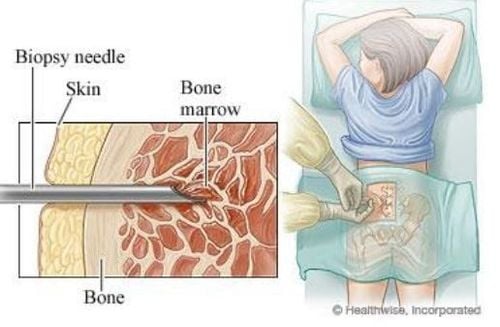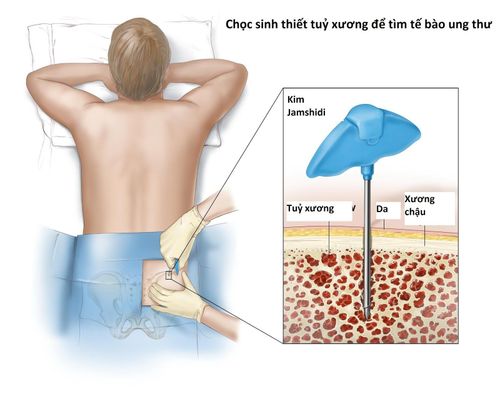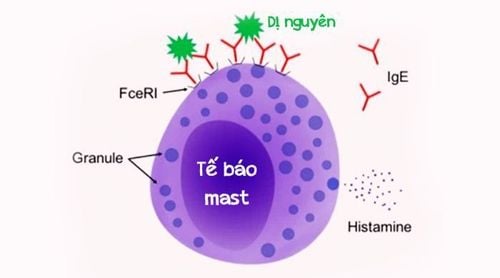This is an automatically translated article.
Bone marrow biopsies and bone marrow aspiration are procedures to sample and examine bone marrow - the spongy tissue inside large bones. They can tell doctors if a person's bone marrow is healthy and making enough blood cells? In addition, this test often evaluates blood and bone marrow diseases such as cancer and unexplained fever. These two techniques are often performed at the same time because they complement each other.
1. Who needs a bone marrow biopsy and aspiration?
Those who need to perform bone marrow biopsy and bone marrow aspiration include:
Blood cell conditions such as erythropoiesis, leukopenia, leukocytosis, thrombocytopenia, thrombocytopenia, pancytopenia and polycythemia of unknown cause; Cancers of the blood or bone marrow, including: Leukemia, lymphoma and multiple myeloma; Cancer that has spread from other areas such as breast cancer that has spread to the bone marrow; Primary iron overload disorder; Fever of unknown cause.
2. Who should not have a bone marrow biopsy?
There are no absolute contraindications to biopsy and bone marrow aspiration. However, some relative contraindications should be noted as follows:
Infection of the puncture site, usually the posterior iliac crest; Thrombocytopenia and blood clotting diseases; Biopsy of the sternum can be performed in some special cases but is not routine because of the patient's psychological problems as well as the higher risk.

Sinh thiết tủy xương và chọc hút tủy xương
3. How are bone marrow biopsies and aspiration performed?
Bone marrow studies are usually done in an outpatient setting. Special preparations are usually not needed. First, be sure to properly identify the patient and explain the procedure, and check vitals before the procedure.
3.1. Bone marrow aspiration Patient is prone or lying on their side; Locate the puncture site, usually the apex of the posterior iliac crest (posterior iliac crest); Disinfect and anesthetize the sampling site; Make a small incision in the skin to insert a hollow needle through the bone and into the bone marrow; The doctor will then attach a syringe to the needle and aspirate a sample of bone marrow fluid; The procedure takes about a few minutes. 3.2. Bone marrow biopsy The same sample of the skin above can be obtained but the needle is entered at a different angle and a larger needle is used to obtain a solid tissue sample of bone marrow. The doctor will rotate the needle clockwise until the tissue sample is obtained (Tissue sample is about 2 cm in length); Then, the doctor will completely withdraw the needle and apply pressure to the injection site.
4. Follow-up after biopsy and bone marrow aspiration
Follow-up after biopsy and bone marrow aspiration, gently press on the puncture site to help stop the bleeding (for a few minutes or so if the patient has coagulopathy), then cover the site with gauze bacteria. Sterile gauze can be removed after 24 hours but should be monitored for signs of infection and late bleeding at the sampling site.
Patients may feel pain for 1 week or longer after a bone marrow examination. Talk to your doctor about taking pain relievers.
The patient should contact the doctor if there are signs such as:
Bleeding that does not stop despite direct pressure on the procedure site; Prolonged fever; Swelling at the site of the procedure; More redness or discharge at the procedure site. In summary, bone marrow biopsy and bone marrow aspiration is a test to diagnose blood diseases, genetic disorders. The results of a bone marrow biopsy will provide a lot of important information, helping the doctor decide on the treatment method for the patient. Therefore, patients should choose reputable medical facilities with modern machinery and equipment to perform.
Please dial HOTLINE for more information or register for an appointment HERE. Download MyVinmec app to make appointments faster and to manage your bookings easily.
REFERENCES
Bone marrow biopsy and aspiration - Mayo Clinic Bone Marrow Aspiration and Biopsy | NEJM (remotexs.co)













